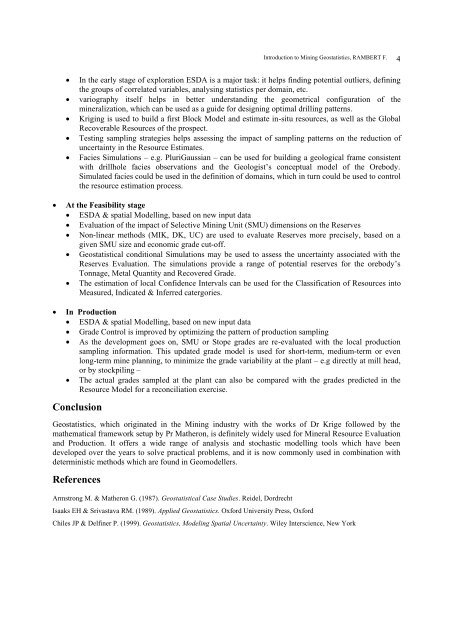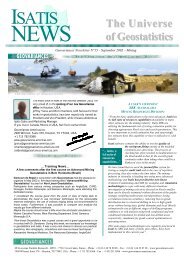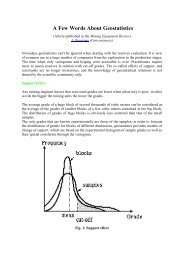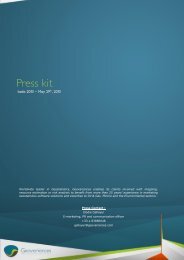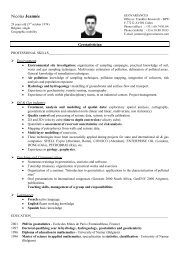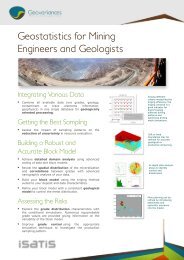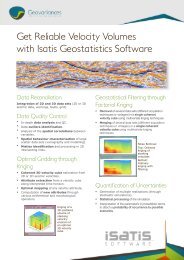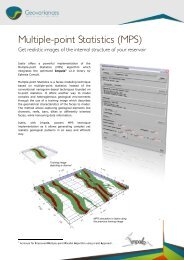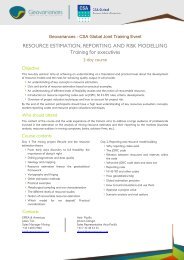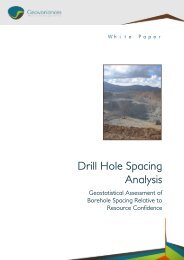Introduction to Mining Geostatistics - Geovariances
Introduction to Mining Geostatistics - Geovariances
Introduction to Mining Geostatistics - Geovariances
You also want an ePaper? Increase the reach of your titles
YUMPU automatically turns print PDFs into web optimized ePapers that Google loves.
<strong>Introduction</strong> <strong>to</strong> <strong>Mining</strong> <strong>Geostatistics</strong>, RAMBERT F. 4<br />
<br />
<br />
<br />
<br />
<br />
In the early stage of exploration ESDA is a major task: it helps finding potential outliers, defining<br />
the groups of correlated variables, analysing statistics per domain, etc.<br />
variography itself helps in better understanding the geometrical configuration of the<br />
mineralization, which can be used as a guide for designing optimal drilling patterns.<br />
Kriging is used <strong>to</strong> build a first Block Model and estimate in-situ resources, as well as the Global<br />
Recoverable Resources of the prospect.<br />
Testing sampling strategies helps assessing the impact of sampling patterns on the reduction of<br />
uncertainty in the Resource Estimates.<br />
Facies Simulations – e.g. PluriGaussian – can be used for building a geological frame consistent<br />
with drillhole facies observations and the Geologist’s conceptual model of the Orebody.<br />
Simulated facies could be used in the definition of domains, which in turn could be used <strong>to</strong> control<br />
the resource estimation process.<br />
<br />
At the Feasibility stage<br />
ESDA & spatial Modelling, based on new input data<br />
Evaluation of the impact of Selective <strong>Mining</strong> Unit (SMU) dimensions on the Reserves<br />
Non-linear methods (MIK, DK, UC) are used <strong>to</strong> evaluate Reserves more precisely, based on a<br />
given SMU size and economic grade cut-off.<br />
Geostatistical conditional Simulations may be used <strong>to</strong> assess the uncertainty associated with the<br />
Reserves Evaluation. The simulations provide a range of potential reserves for the orebody’s<br />
Tonnage, Metal Quantity and Recovered Grade.<br />
The estimation of local Confidence Intervals can be used for the Classification of Resources in<strong>to</strong><br />
Measured, Indicated & Inferred catergories.<br />
<br />
In Production<br />
ESDA & spatial Modelling, based on new input data<br />
Grade Control is improved by optimizing the pattern of production sampling<br />
As the development goes on, SMU or S<strong>to</strong>pe grades are re-evaluated with the local production<br />
sampling information. This updated grade model is used for short-term, medium-term or even<br />
long-term mine planning, <strong>to</strong> minimize the grade variability at the plant – e.g directly at mill head,<br />
or by s<strong>to</strong>ckpiling –<br />
The actual grades sampled at the plant can also be compared with the grades predicted in the<br />
Resource Model for a reconciliation exercise.<br />
Conclusion<br />
<strong>Geostatistics</strong>, which originated in the <strong>Mining</strong> industry with the works of Dr Krige followed by the<br />
mathematical framework setup by Pr Matheron, is definitely widely used for Mineral Resource Evaluation<br />
and Production. It offers a wide range of analysis and s<strong>to</strong>chastic modelling <strong>to</strong>ols which have been<br />
developed over the years <strong>to</strong> solve practical problems, and it is now commonly used in combination with<br />
deterministic methods which are found in Geomodellers.<br />
References<br />
Armstrong M. & Matheron G. (1987). Geostatistical Case Studies. Reidel, Dordrecht<br />
Isaaks EH & Srivastava RM. (1989). Applied <strong>Geostatistics</strong>. Oxford University Press, Oxford<br />
Chiles JP & Delfiner P. (1999). <strong>Geostatistics</strong>, Modeling Spatial Uncertainty. Wiley Interscience, New York


